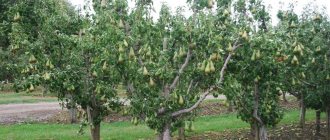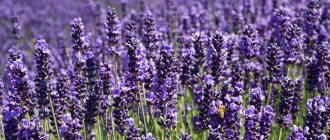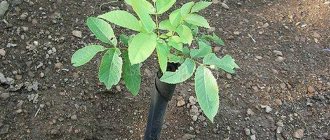How to plant bulbous flowers correctly?
And by the way, we already have corm flowers on sale! Come visit, order in the online store (Delivery throughout Russia).
All bulbous and corm flowers can be divided into frost-resistant, which winter safely in our area, and heat-loving, requiring storage at above-zero temperatures. Surprisingly, heat-loving sissies, if they have been successfully preserved until spring, almost always bloom, while daffodils or tulips can only produce leaves every year and not produce flowers.
Why is this happening?
Firstly , each type of bulbous plant has its own characteristics. Some live in one place for a long time, bloom and do not require frequent replanting. Others quickly become overgrown with numerous baby bulbs and lack space and nutrients. There are also those that require a period of rest in dry and warm soil in the summer, only then do they develop flower buds. In climate zones with dry summers, they are not dug up, but where the summers are cool and rainy, the bulbs must be dug up, sorted, dried in the shade, and planted in the fall.
Secondly , proper planting of the bulbs is crucial. If bulbs do not bloom, then experienced gardeners always give advice: dig up the bulbs and plant them correctly.
What is needed for abundant flowering of bulbous plants?
Most of our popular garden bulbous flowers are not at all capricious, do not require complex care, and grow well in different soils. The main thing is to plant it correctly. What is important:
- choice of location;
- soil preparation;
- healthy bulbs;
- correct planting depth;
- correct landing time.
The main requirements for planting bulbs of tulips, daffodils, snowdrops, hyacinths, muscari, crocuses, and many other bulbs are soil preparation, fertilization, healthy bulbs. Planting time is also very important.
Kandyk (erythronium)
Depending on the weather, it blooms in April or May and pleases the eye for 2-3 weeks. Plan to plant this crop in September; in the warm autumn you can postpone the procedure to October. The planting depth of the bulbs is 5-7 cm, the interval between them is 15-17 cm. To maintain their decorative appearance, plant the bushes every 4-5 years.
Kandyk (erythronium)
Choosing a place for bulbous flowers
Almost all garden bulbs do not tolerate stagnation of moisture in the soil. In wetlands, the bulbs rot. If there is melt water in your garden for a long time, if the groundwater level is high, then the best place for bulbous plants is a slope, an alpine hill or a high flower bed.
Early spring flowers - galanthus, muscari, crocuses - can be safely planted under trees. Their growing season occurs during a period when the trees are still practically without leaves and have enough light.
Small bulbs in one place can grow from 4 to 10 years, so it is better to plant them among ground cover plants or between perennials. You can plant small bulbous flowers on the lawn.
Autumn landing
Every summer resident strives to get as much information as possible about how and when to plant bulbous flowers in the ground before winter in order to provide them with reliable protection even before the onset of cold weather.
Selecting a location
To prevent flower bulbs from rotting and to keep the plants healthy, it is very important to choose the right place for planting and create the appropriate conditions for harmonious development and flowering. The site is chosen to be flat, without depressions or holes, and the groundwater level should be:
- below 70 cm (for tulips, crocuses and daffodils);
- below 60 cm (for hyacinths).
These conditions must be strictly observed, otherwise the plants will get wet and die. Hyacinth bulbs do not have a protective thick skin, so they are very sensitive to waterlogging of the soil and quickly rot. To plant these plants, raised ridges are created using drainage .
A site with the following characteristics is suitable for planting bulbous plants:
- Good lighting.
- Protection from wind and draft.
- Possible shading with sparse bushes or deciduous trees (for daffodils and crocuses).
- The soil is neutral acidity (PH up to 7.8).
Soil preparation
The requirements for the composition and quality of soil for bulbous flowers are largely similar. It must have the following properties:
- Conductivity of moisture.
- Air conductivity.
- Looseness.
- Fertility.
Fertile, light soil with a well-designed drainage system is perfect for all plants in this group.
The most suitable soils for tulips are loose neutral or slightly alkaline soils. Daffodils like loam soils, hyacinths grow best in sandy loam soils, and crocuses have no special requirements. For them, the main thing is that the soil is light, fertile, with a good drainage system.
Before planting flower beds, dense clay soils are improved by adding coarse fractions of river sand (20 kg per 1 sq.m.). Soil with a high sand content is enriched with peat and humus (15 kg per 1 sq.m.). If the soil is acidic, you need to add limestone to it at the rate of 200-500 grams per 1 sq.m of land. Wood ash will help reduce increased soil acidity .
In addition, in order to increase water, breathability and soil fertility, the following is added to it:
- peat or compost (2 buckets per 1 sq.m);
- wood ash (100-150 g per 1 sq.m);
- superphosphate (50 g per 1 sq.m);
- potassium sulfate (30 g per 1 sq.m);
- ammonium nitrate (25 g per 1 sq.m.).
When improving the soil for daffodils with mineral fertilizers, you need to remember that they most of all need phosphorus and potassium, which ensure full root growth , flowering, and the production of sugar and starch. Nitrogen is an element that helps form plant organs and tissues. If used excessively, it can cause active growth of green mass, the plant becomes weak and is easily susceptible to diseases. Therefore, when planting daffodils in the fall, you should not get carried away with these fertilizers.
Do not overdo it with fertilizing for crocuses . When planting them, it is best to apply phosphorus or potassium fertilizers, and nitrogen fertilizers should be abandoned altogether.
Site preparation should begin in August to allow the soil to settle naturally and subsequently not damage the fragile plant roots. Before planting flowers, the area needs to be loosened, leveled, and weeds removed. The newly reclaimed area is cleared of debris and stones. Then humus or sand is evenly distributed on the surface of the area. The earth needs to be dug up to a depth of 35-40 cm . Fertilizers are then added to the soil . After this, the site is dug up again, leveled with a rake and left alone for 1-2 months until the flowers are planted. Using fresh manure to fertilize the soil is strictly prohibited!
Subsequently, for good flowering, fertilizers must be applied to the soil in several stages:
- after the first shoots appear;
- before the buds open;
- after flowering ends.
How to choose healthy bulbs?
Before planting, the dug up bulbs need to be sorted out. Remove all damaged, moldy, and rotten spots. Not only will they not produce good flowering, but they can infect other plants with fungal diseases.
Immediately before planting, it is advisable to treat the bulbs with a pink solution of potassium permanganate for 30-60 minutes.
Helpful advice. If you have a lot of “defective” bulbs of tulips, daffodils, and crocuses, don’t rush to throw them in the trash. It is more practical to soak them for an hour in potassium permanganate and plant them away from flower beds, somewhere in an abandoned corner of the garden, near a fence or shed. You will be surprised, but many of them will bloom in the spring, and if you dig up the soil at the end of summer, you will find quite healthy large bulbs.
After the purchase
If you ordered bulbs from a catalog, then after unpacking the parcel, immediately separate the planting material of the crops ordered for forcing and place it in storage in accordance with the recommendations. It’s time to plant the bulbs intended for very early forcing (Catholic Christmas, New Year) in pots and put them in the refrigerator for rooting. We carefully inspect the rest, dry the damp ones on the way in the shade and leave them in a dark (!), well-ventilated, cool, but not cold, room with a temperature of 15...17°C until planting.
If the bulbs by nature do not have a good covering of dry scales (snowdrop, whiteflower, scilla, chionodoxa, pushkinia, kandyk, hazel grouse, decorative onions), then it is better to store them in slightly damp peat, sand or sawdust until planting. If roots appear on the bottom of the bulbs during shipment, do not wait for the optimal planting time and plant the plants in the ground.
The rest of the planting material can be planted in the flower garden, adhering to the timing recommended for your zone. Traditionally popular with our flower growers:
- tulips,
- daffodils,
- hyacinths,
- decorative giant bows,
- and imperial hazel grouse.
From small bulbous ones:
- crocuses,
- Scylla,
- scillas,
- Muscari.
The agricultural technology for growing them has long been known and planting them in the ground does not involve any special tricks. The main thing is that there is loose, fertile soil, where melt water does not stagnate during winter thaws, and during the flowering period the plants receive enough sunlight.
When to plant bulbs?
The planting period for bulbs may vary annually, and be different in each region. Everything depends on climatic conditions, namely soil temperature. The soil temperature at a depth of 10 cm should be no more than + 9 - 10 degrees C. The best period for planting bulbous flowers begins in mid-September and continues until early November.
Once in the ground, the bulbs must produce roots before the soil freezes, after which further development of the bulb stops with the onset of winter. The rooting time of the bulbs is up to 30 days after planting the bulb.
Small bulbous plants should be planted first: muscari, crocuses, snowdrops. Daffodils are planted in mid-September. If they are planted later, they will not develop enough roots.
The end of September is the time to plant hyacinths. Hyacinths require more fertile soil; the amount of organic matter is increased to 6 kg per 1 m2.
It is recommended to plant tulips in early October, although the timing depends on the variety. It should be noted that many specialists do this earlier.
These dates are approximate. In the northern regions, it is likely that the soil will freeze earlier; planting dates will be shifted to the end of summer. In the south, you can plant bulbs later, but spring comes earlier here, many species bloom in February-March, and before that time they must have time to go through their entire development cycle.
Hyacinthoides
Flowering of this plant lasts 1-2 weeks and, depending on the weather, can occur from mid-March to mid-May. After flowering, wait until the foliage on the plants turns yellow, dig up the bulbs, and plant them in the ground again in the fall. Favorable period for planting
- from the second half of September to mid-October. Place large bulbs with a diameter of about 5 cm at intervals of 15-20 cm, deepening them to 15-18 cm. Smaller specimens can be planted more densely and not so deeply.
Hyacinths
You can read more about growing these flowers in the publication on our website Hyacinths in your garden: planting and care.
Flowering of this crop begins at the end of May and lasts 20-25 days. Start planting bulbs in the 3rd ten days of September or the 1st ten days of October, placing them on the bed at intervals of 15-20 cm and deepening them by 10-15 cm. To maintain the decorative appearance of the plant, plant overgrown bushes once every 3-4 years .
Hyacinthoides
Bulb planting depth
The planting depth of various bulbous flowers depends on the size of the bulb itself. The basic rule is simple: the planting depth is equal to three times the height of the bulb. The exception is the bulbs of daffodils and hyacinths; we plant them at double height. For example, if a bulb reaches 4 cm in height, we plant it at a depth of 12 cm. Children usually do not bury as deep as adult bulbs (although this sometimes causes them to freeze out).
The distance between the bulbs also depends on their size. When forming a flower bed, you need to know the height of each flower. Low bulbous flowers are planted in the foreground. Large tulip and daffodil bulbs are planted at a distance of 10 cm from each other, and the distance between rows is 25 cm.
It should be noted that a beautiful flower bed is obtained if the bulbs are planted densely. But with this placement, the plants do not have enough nutrition to form a new bulb after flowering. For ceremonial flower beds, exactly this method of planting is used, removing the plants completely after flowering and filling the vacant space with prepared seedlings of other species. The usual planting method involves combining bulbous plants with other types of plants. Tulips are planted with arabis, forget-me-nots, pansies, periwinkle, daffodils go well with muscari. It is best if, when planting together, the roots of the plants are located at different depths.
Pushkinia
This crop blooms in April-May, and requires replanting only once every 5-6 years. After the foliage has dried, carefully remove the plant from the ground, separate the bulbs, dry and store until autumn. Plant onions in September
to a new place with an interval of at least 10 cm, deepening it into the ground by 5-7 cm.
Pushkinia
You can read more about this charming plant in the article Pushkinia - a shy person or a star of the spring garden?
What else do you need to know
When planting, bulbs should not be pressed into the soil with force, so as not to damage the root roll. After planting, the area should be leveled so that water does not stagnate in the planting holes.
If autumn is dry, then the places where bulbous flowers are planted need to be watered regularly. With the onset of frost, it is advisable to mulch the place where the bulbs are planted with compost or dry leaves. Small baby bulbs are covered especially carefully. They are planted closer to the surface and the risk of freezing is greater.
We are on social networks: Feel free to join groups, write comments, read and discuss daily articles on social networks!











